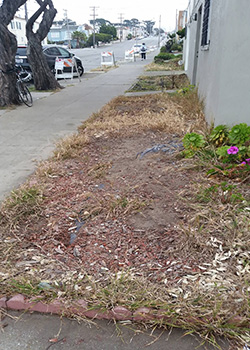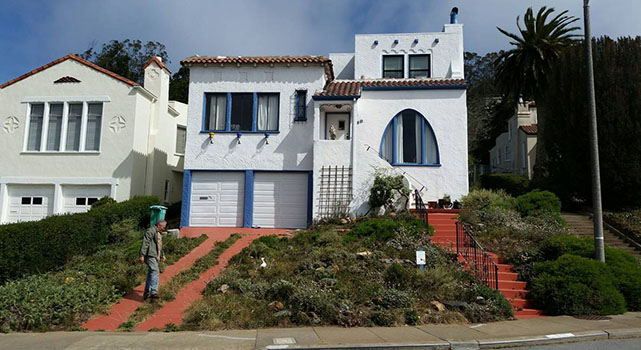The grand prize winner of the San Francisco's Ugliest Yard competition, sponsored by the San Francisco Department of the Environment (SF Environment), will be announced this month.

This property received the most votes for ugliest yard from visitors to the SF Environment website. Photo courtesy of SF Environment
By Bill Picture
Published: June, 2015
The grand prize winner of the San Francisco’s Ugliest Yard competition, sponsored by the San Francisco Department of the Environment (SF Environment), will be announced this month.
In early April, San Francisco property owners with embarrassing weed patches, unsightly dead lawns and other landscaping misses were invited to upload photos of their plots to the SF Environment website for a chance to win a yard makeover by Madrono Landscape Design Studio, which specializes in replanting outdoor spaces with native, drought-resistant plant species. The public was then encouraged to visit the site to help choose the yard most in need of some love.
The competition was created to help the San Francisco Planning Department promote its new SF Plant Finder website, where anyone interested in greening an outdoor space can learn more about the plant species that thrive in San Francisco’s unique climate, which can be tricky for even those boasting the greenest of thumbs.
“Eventually, the SF Plant Finder site will also include a list of local nurseries where people can shop for these native plants,” said Peter Brastow, SF Environment’s biodiversity coordinator. “Ultimately, the goal is conserving water.” Studies conducted by the EPA show that in drier climates, up to 60 percent of a household’s water is used outdoors. The biggest culprit is traditional landscaping, especially lawns, which require regular watering to stay green.
SF Environment’s effort to promote water conservation is radically different than the strategies implemented by other California municipalities in the face of ongoing drought conditions. Many have imposed restrictions on outdoor water use, with violators facing stiff penalties for misuse or overuse.
In wealthier SoCal neighborhoods, where sprawling green lawns and well-tended gardens are considered status symbols, city officials and the local media are publicly shaming property owners for ignoring water restrictions. When aerial photos of the meticulously manicured emerald-green lawns at Barbara Streisand’s Malibu estate ran in newspapers all over the world, for example, a red-faced Babs pledged to go easy on the sprinklers moving forward.
“But it’s not just water overuse that we’re concerned about,” Brastow said. “It’s also the chemicals being used to keep lawns and gardens bug-free and weed-free.”
“When traditional landscaping is replaced with native plant species, nature does a lot of the work for you. It still needs stewardship, however—not as much as a traditional lawn, but it needs love.”
“A lot of ugly yards”
Brastow admits he was surprised by the number of yards entered in the competition. While SF Environment boasts one of San Francisco’s strongest outreach programs, it only set out to receive 30 entries.
“That’s the bar we set internally as ‘we did a good job.’ And we ended up with 79 entries. It turns out there are a lot of ugly yards in San Francisco.” Of those 79 entries, some didn’t receive a single vote, but one received more than a thousand votes.
The votes from visitors to the SF Environment website will decide the three first-prize winners, who will each receive a landscaping consultation from Brastow and enough native plant seeds and compost to make over a 500-square-foot plot of land. The grand-prize winner will be decided by a panel of judges from SF Environment and some of its sister agencies.
“The number of votes that a yard received is definitely taken into consideration, but there are other criteria as well,” said Brastow. Extra points will be awarded to yards in historically underserved communities, and in concrete-heavy neighborhoods that could use more green spaces. Front yards and yards that are visible from the street will also get bonus points.
“It’s important to mention that the makeover cannot include concrete removal,” Brastow said. Over the years, many property owners have replaced permeable soil with concrete slabs. While concrete is definitely drought-friendly, storm runoff carries harmful pollutants to storm drains that empty into the Bay. While a brown lawn is an eyesore and may raise neighbors’ eyebrows, the decision not to water—whether intentional or the result of sheer laziness—is a much greener one than paving.
“They’re on the right track whether they know it or not,” Brastow said of people who let their yards turn brown instead of paving. “But storm runoff from concrete is a whole different problem. Plus concrete removal can be expensive.”
Brastow hopes that by making competition entrants and voters aware of SF Plant Finder’s existence, they’ll be inspired to switch out their thirsty lawns and gardens for something greener. “If they entered the competition or voted, then they have some interest in greening their properties. That’s our hope. So even if they didn’t win, we hope that by providing the information they need to green their yard on that website, we’re empowering them to make that choice.”
For more information on the “San Francisco’s Ugliest Yard Competition,” visit www.sfenvironment.org/ugliest-yard. For more information on SF Plant Finder, visit sfplantfinder.org.

The purpose and hope of the Ugliest Yard competition is to inspire people to switch out their thirsty lawns and gardens for something drought-tolerant like the yard of this home. Photo by Peter Brastow

